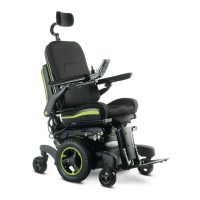16 Jive Up / QM-710 Stand Up
Rev.2.0
4.33 Kerb climbing
WARNING!
Always approach a kerb at 90° (Fig 4.3).
Approach the kerb (step) head on driving forwards slowly
and steadily and always at a 90° angle.
Stop the chair as soon as the castor wheels touch the
kerb.
Apply sufficient power to the motors to lift the front of
the chair up onto the kerb (step) and then apply slightly
more power and speed so that the drive wheels climb
the kerb (step) smoothly and without hesitation. As far
as possible, keep the joystick in the straight forward
position.
In accordance to the ground clearance, the maximum
obstacle height possible to climb is 10 cm when
conducted as described above.
WARNING!
The approach speed and process can vary depending
on your wheelchair drive type and castor wheel choice.
Fig.4.3
4.33.2 Dismounting the kerb.
WARNING!
Move the chair slowly and carefully in a forward direction
until both front wheels are on the edge of the kerb, again
in a 90° position to the kerb. (Fig 4.3 )
Drive as slowly as possible off the kerb with the drive
wheels. Don’t stop the chair during decent of the kerb.
You will feel more secure if you can lean backwards,
but if you can’t, don’t worry, the wheelchair is extremely
stable. As long as you stay within its limitation, you will
be quite safe.
The rear of the chair will naturally follow down the kerb
as you continue to drive slowly forwards.
All powered seating options need to be in home position.
Your powered leg rests may need to be adjusted to give
enough clearance to mount or dismount the kerb.
We recommend to use the lap strap to feel more secure
during declining the kerb. For extra protection we
recommend to fit every chair with the leg rests.

